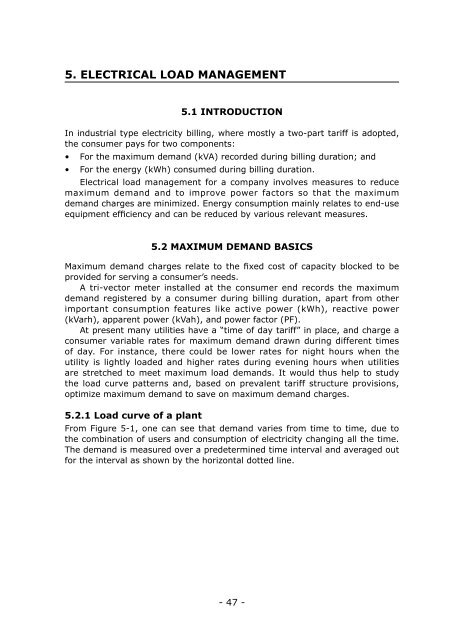Training Manual on Energy Efficiency - APO Asian Productivity ...
Training Manual on Energy Efficiency - APO Asian Productivity ...
Training Manual on Energy Efficiency - APO Asian Productivity ...
Create successful ePaper yourself
Turn your PDF publications into a flip-book with our unique Google optimized e-Paper software.
5. ELECTRICAL LOAD MANAGEMENT<br />
5.1 INTRODUCTION<br />
In industrial type electricity billing, where mostly a two-part tariff is adopted,<br />
the c<strong>on</strong>sumer pays for two comp<strong>on</strong>ents:<br />
• For the maximum demand (kVA) recorded during billing durati<strong>on</strong>; and<br />
• For the energy (kWh) c<strong>on</strong>sumed during billing durati<strong>on</strong>.<br />
Electrical load management for a company involves measures to reduce<br />
maximum demand and to improve power factors so that the maximum<br />
demand charges are minimized. <strong>Energy</strong> c<strong>on</strong>sumpti<strong>on</strong> mainly relates to end-use<br />
equipment efficiency and can be reduced by various relevant measures.<br />
5.2 MAXIMUM DEMAND BASICS<br />
Maximum demand charges relate to the fixed cost of capacity blocked to be<br />
provided for serving a c<strong>on</strong>sumer’s needs.<br />
A tri-vector meter installed at the c<strong>on</strong>sumer end records the maximum<br />
demand registered by a c<strong>on</strong>sumer during billing durati<strong>on</strong>, apart from other<br />
important c<strong>on</strong>sumpti<strong>on</strong> features like active power (kWh), reactive power<br />
(kVarh), apparent power (kVah), and power factor (PF).<br />
At present many utilities have a “time of day tariff” in place, and charge a<br />
c<strong>on</strong>sumer variable rates for maximum demand drawn during different times<br />
of day. For instance, there could be lower rates for night hours when the<br />
utility is lightly loaded and higher rates during evening hours when utilities<br />
are stretched to meet maximum load demands. It would thus help to study<br />
the load curve patterns and, based <strong>on</strong> prevalent tariff structure provisi<strong>on</strong>s,<br />
optimize maximum demand to save <strong>on</strong> maximum demand charges.<br />
5.2.1 Load curve of a plant<br />
From Figure 5-1, <strong>on</strong>e can see that demand varies from time to time, due to<br />
the combinati<strong>on</strong> of users and c<strong>on</strong>sumpti<strong>on</strong> of electricity changing all the time.<br />
The demand is measured over a predetermined time interval and averaged out<br />
for the interval as shown by the horiz<strong>on</strong>tal dotted line.<br />
- 47 -
















